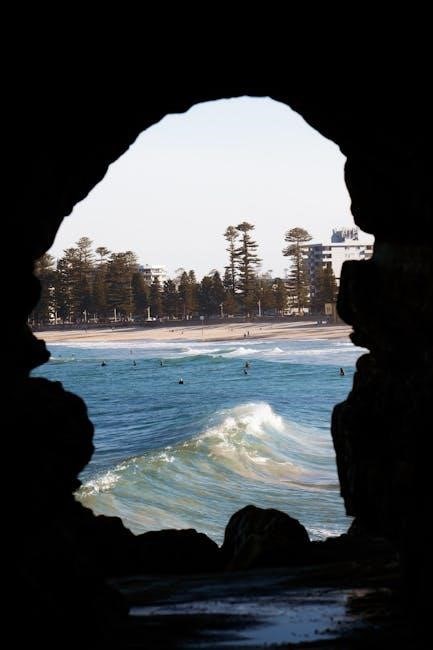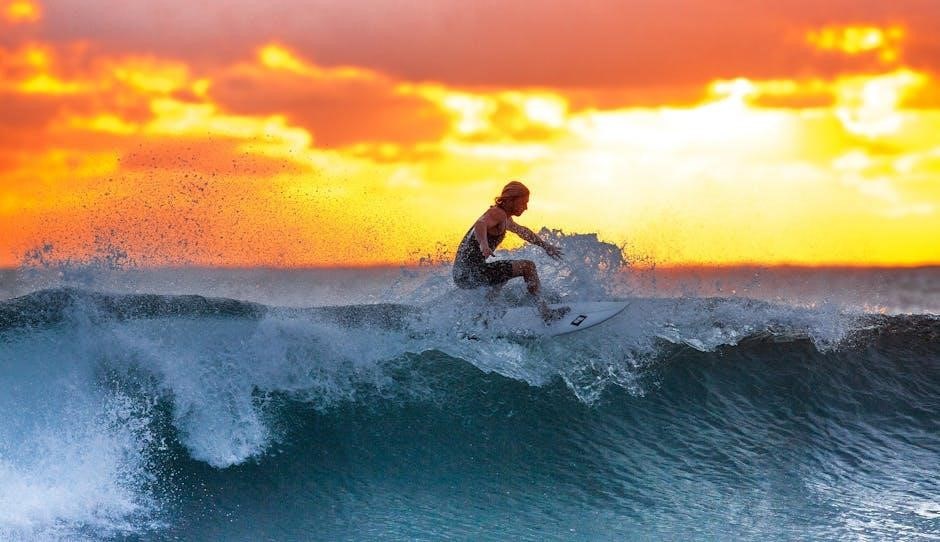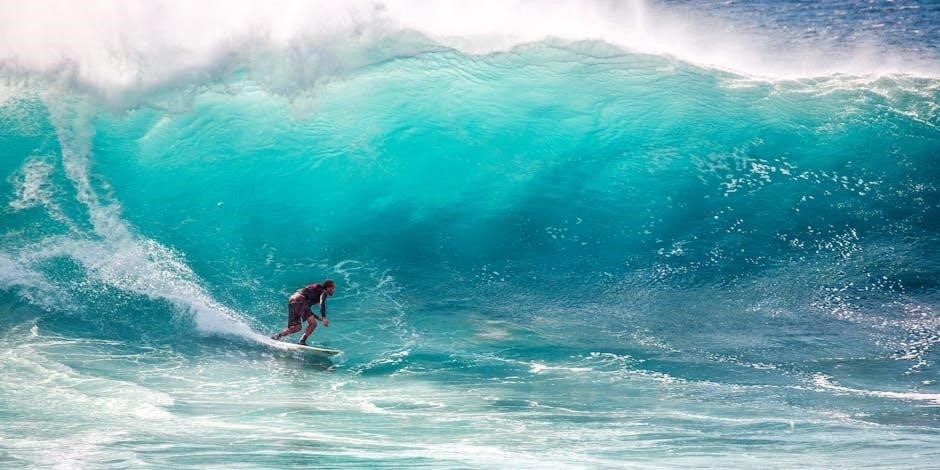
Welcome to the world of surfing! Choosing the right surfboard is the first step in your surfing journey. This guide will help you navigate the process, ensuring you find the perfect board based on your skill level, budget, and personal preferences. Let’s dive in and explore the key factors to consider when selecting your ideal surfboard.

Types of Surfboards
Surfboards vary in design, catering to different styles and skill levels. Common types include:
-
Shortboard
⸺ Ideal for advanced surfers, offering speed and maneuverability.
-
Longboard
⸺ Great for cruising, providing stability and ease of catching waves.
-
Funboard
⸺ A versatile option for all levels, balancing performance and stability.
-
Softboard
⸺ Perfect for beginners, with a soft foam surface for safety.
-
Stand-Up Paddleboard (SUP)
⸺ Designed for paddling while standing, offering a core workout.
A shortboard is a popular choice among advanced surfers, offering exceptional maneuverability and speed. Typically ranging from 5’8″ to 7′ in length, these boards are ideal for catching waves in various conditions. Their streamlined design allows for sharp turns and quick transitions, making them perfect for experienced riders. Shortboards usually have a rounded or squashed tail, enhancing control and precision. They are generally thinner and have less volume, which can make them more challenging for beginners to balance on. However, for surfers looking to push their limits and ride more dynamically, a shortboard is an excellent option. When selecting a shortboard, consider factors like rocker (the board’s curve) and fin setup, as these significantly impact performance. With the right shortboard, you can elevate your surfing to new heights and enjoy a more responsive ride.
A longboard is an excellent choice for surfers seeking stability and ease of catching waves. Typically ranging from 8 to 14 feet in length, longboards are ideal for cruising and carving on smaller waves. Their rounded noses and soft edges provide buoyancy, making them perfect for beginners who need help balancing. The larger surface area and volume of longboards allow for smooth glide and forgiveness, which is great for learning basic surfing techniques. Experienced surfers also enjoy longboards for their classic style and the ability to perform graceful turns. Whether you’re riding small waves or enjoying a relaxing session, a longboard offers a versatile and enjoyable surfing experience. They are particularly popular in beach breaks and are often recommended for those looking to build confidence in the water.
A funboard is a versatile surfboard designed for intermediate surfers, offering a balance between stability and maneuverability. Typically ranging from 7 to 9 feet in length, funboards are wider and thicker than shortboards, making them easier to catch waves and stay afloat. Their soft-top construction or foamie options are ideal for beginners, while experienced riders can enjoy their performance in various wave conditions. Funboards are great for improving skills, as they provide forgiveness during turns and allow for smooth transitions between waves. They’re also a fantastic choice for surfers who want to progress from softboards to harder, more responsive boards. With their user-friendly design, funboards are perfect for those seeking a fun and forgiving ride, whether you’re cruising on small waves or challenging yourself in bigger surf.
A softboard, also known as a foamie, is an excellent choice for beginners and those prioritizing safety and durability. Constructed from soft, foam materials, these boards are lightweight and buoyant, making them easy to handle and forgiving for new surfers. The soft exterior reduces the risk of injury from collisions, while the foam core provides excellent stability in the water. Softboards often feature soft fins, which are safer than traditional fiberglass or carbon fins. They are ideal for learning the basics of surfing, as they are easy to balance on and glide smoothly over small waves. Many surf schools use softboards for lessons due to their durability and safety features. Despite being geared toward beginners, softboards can also be a fun option for experienced surfers looking to enjoy casual, low-pressure sessions in gentle conditions.
A Stand-Up Paddleboard (SUP) is a versatile and popular choice for both surfing and flat-water paddling. Designed for stability and ease of use, SUPs are ideal for beginners and experienced paddlers alike. They typically range from 10 to 14 feet in length and have a thick, buoyant design that makes balancing easier. SUPs are perfect for calm waters, such as lakes or slow-moving rivers, and can also handle small waves. Their large size and soft top options make them a great choice for families or those looking for a relaxed, fun experience. Additionally, SUPs are excellent for fitness, as paddling works multiple muscle groups. If you’re looking for a board that combines surfing with paddling adventures, a SUP is an excellent option to explore.
Factors to Consider When Buying a Surfboard
When buying a surfboard, consider factors like performance, stability, and durability. Think about your surfing style, wave conditions, and how the board will grow with your skills.
Budget Considerations
Setting a realistic budget is essential before purchasing a surfboard. Prices vary widely, ranging from $300 for soft-top boards to over $1,000 for high-end models. Consider your skill level, surfing frequency, and the type of board you need. New surfboards can be a significant investment, but they offer better performance and durability. If you’re on a tight budget, consider used or soft-top boards, which are more affordable and ideal for beginners. Research local surf shops or online retailers to compare prices and find deals. Additionally, factor in the cost of accessories like leashes, wax, and bags. While it’s tempting to overspend, balance your budget with the quality and performance you need. A well-considered budget ensures you find a surfboard that meets your needs without financial strain.
Size and Volume
Size and volume are critical factors when selecting a surfboard, as they directly impact performance and usability. The size of the board, including length and width, determines stability and maneuverability. Generally, larger boards are more buoyant, making them easier to catch waves and ideal for beginners or smaller wave conditions. Volume, measured in liters, reflects how much water the board displaces. Higher volume boards float better, while lower volume boards are more responsive but require more skill to manage. Your weight, skill level, and the type of waves you’ll be surfing play a significant role in choosing the right size and volume. For example, heavier surfers or those in smaller waves may benefit from more volume for stability. Balancing these elements ensures you find a board that suits your needs and enhances your surfing experience.
Shape and Nose Type
The shape and nose type of a surfboard play a crucial role in its performance and suitability for different surfing styles. A rounded nose offers stability and is ideal for beginners, while a pointed nose provides speed and control for advanced surfers. Squared noses strike a balance, offering maneuverability for intermediate riders. The overall shape of the board, whether it’s a classic shortboard or a modern funboard, determines its buoyancy and responsiveness in the water. Consider your surfing ability and the types of waves you’ll be riding to choose the right shape and nose type for your needs. This decision will significantly impact your surfing experience and progress.
Tail Shape
The tail shape of a surfboard plays a significant role in its performance and maneuverability. Common tail shapes include the squash, round, and pintail. A squash tail offers a balance of speed and control, making it versatile for most surfing conditions. Round tails are ideal for carving and provide hold in more powerful waves, while pintail tails are designed for speed and direction, often favored by advanced surfers. The choice of tail shape depends on your surfing style, the type of waves you ride, and your skill level. For beginners, a squash tail is often recommended due to its stability and forgiveness. Intermediate and advanced surfers may prefer more specialized tail shapes to match their riding preferences. Consider your needs and the wave conditions you’ll encounter most frequently when selecting a tail shape for your surfboard.
Fin Setup
The fin setup on a surfboard plays a crucial role in its performance, affecting stability, maneuverability, and speed. Common configurations include single fins, twin fins, thrusters (three fins), and quads (four fins). Single fins offer classic stability and control, ideal for longboards and cruising. Twin fins provide liveliness and playfulness, great for intermediate surfers. Thrusters are versatile and popular, delivering a balance of drive and agility for all levels. Quads excel in speed and hold, favored by advanced surfers for high-performance surfing.
Removable fin systems, like FCS or Futures, allow customization and convenience. Glass-on fins are more traditional, offering durability but less flexibility. Choosing the right fin setup depends on your surfing style, skill level, and the type of waves you ride. Experimenting with different configurations can enhance your surfing experience and help you find your perfect setup. Always consider compatibility with your board’s design when selecting fins.

Leash and Accessories
A surfboard leash is an essential accessory that keeps your board attached to your ankle, preventing it from being lost or causing injury to others. When buying a leash, consider the thickness and length, as these factors impact durability and performance. Thicker leashes are more durable but can be less flexible, while thinner ones offer better movement but may wear out faster. Additionally, eco-friendly leashes made from recycled materials are now widely available, combining functionality with sustainability.
Other accessories to consider include a high-quality surfboard bag for protection during transport, a traction pad for better grip, and a set of fins tailored to your board. Wax or a grip coat is also crucial for maintaining traction on the board. Cleaning supplies, such as a soft brush and mild detergent, will help maintain your board’s condition. These small but vital items enhance your surfing experience and ensure your equipment lasts longer.
Skill Level Considerations
Your skill level significantly impacts your surfboard choice. Beginners benefit from stable, buoyant boards like softboards or funboards. Intermediate surfers often prefer shortboards for better performance. Advanced riders can opt for high-maneuverability custom designs. Always match your board to your ability for optimal progression in the water.
Beginner Surfers
If you’re new to surfing, choosing the right board is essential to ensure a safe and enjoyable experience. Softboards, also known as foamies, are highly recommended for beginners due to their soft, forgiving surface, which reduces the risk of injury. These boards are durable and easier to balance on, making them perfect for learning the basics. A board with plenty of volume and a larger size will provide the stability and buoyancy needed for newcomers. Look for a board in the 7–9 foot range, as these lengths are easier to catch waves with and offer better floatation. A rounded nose and a squash tail are ideal features for beginners, as they enhance stability and control. Remember, the right board will keep you safe and help you build confidence in the water.
Intermediate Surfers
As an intermediate surfer, you’ve mastered the basics and are now looking to refine your skills and explore more dynamic performances in the water. At this stage, it’s essential to transition from softboards or funboards to more responsive boards that offer better maneuverability. Consider a shortboard or a high-volume funboard, which will provide the stability you need while allowing you to progress with turns and control. Your budget should reflect the quality and durability of the board, as intermediate surfers often invest in higher-performance options. Assess your surfing frequency and the types of waves you typically ride to narrow down the ideal size, shape, and fin setup for your next board. Balancing volume, rocker, and tail shape will help you advance your technique and enjoy a smoother transition to more challenging surfing conditions.
Advanced Surfers
For advanced surfers, the focus shifts to high-performance boards that deliver precision, speed, and control. Shortboards are typically the go-to choice, offering maneuverability and responsiveness in challenging wave conditions. Advanced riders often prioritize lower volume boards, which allow for tighter turns and better performance in hollow waves. The fin setup is critical, with options like thrusters or quads providing the necessary drive and control. Materials also matter, with many experienced surfers opting for lightweight, durable constructions that enhance performance. When selecting a surfboard, advanced surfers should consider their preferred wave types, whether it’s reef breaks, point waves, or beach breaks. Custom orders from skilled shapers can tailor the board to their exact needs, ensuring optimal performance. Ultimately, the right board for an advanced surfer is one that aligns with their style, skill level, and the specific conditions they frequent.
Materials and Construction
Surfboards are crafted from various materials, each offering unique performance characteristics. Foam boards, often used by beginners, are soft and durable, reducing injury risk. Fiberglass and carbon fiber constructions provide durability and rigidity, ideal for experienced surfers seeking speed and maneuverability. Balsa wood boards combine strength with environmental sustainability. The construction process involves layering materials for strength and buoyancy, ensuring the board withstands ocean conditions. Custom options allow surfers to tailor materials to their preferences. Eco-friendly alternatives, like recycled foam, are gaining popularity. Understanding the materials and construction is crucial for selecting a surfboard that meets your needs and supports sustainable practices.

Custom vs. Off-the-Shelf Surfboards
When deciding between a custom and an off-the-shelf surfboard, consider your surfing goals, budget, and preferences. Custom surfboards are tailored to your specific needs, offering personalized performance and unique designs; They are ideal for intermediate to advanced surfers who know exactly what they want. However, custom boards are more expensive and require a longer wait time. Off-the-shelf surfboards, on the other hand, are readily available, cost-effective, and suitable for most surfers, especially beginners. They come in standard sizes and shapes, making them accessible and easy to purchase. While they may lack the bespoke touch, they often deliver excellent performance for their price. Ultimately, the choice depends on whether you value customization and precision or affordability and convenience.
Environmental Impact
Surfboard production often involves non-recyclable materials like foam and resin, which can harm the environment. Eco-conscious options like recycled foam, balsa wood, and plant-based resins are becoming popular. These materials reduce the environmental footprint while maintaining performance. Many manufacturers now focus on sustainable practices, such as using biodegradable components or repurposing waste materials. When buying a surfboard, consider its lifecycle—durable boards last longer, reducing waste. Repairing dings and extending the board’s life is also eco-friendly. Additionally, buying second-hand or renting can minimize demand for new boards. Finally, support brands that prioritize sustainability and ethical production methods. By making informed choices, you can enjoy surfing while helping to protect the planet for future generations.

Maintenance and Care
Proper maintenance and care are essential to extend the life of your surfboard. Regularly rinse your board with fresh water after use to remove salt and debris. Avoid exposing it to direct sunlight for extended periods, as this can cause delamination. Store your board in a cool, dry place or use a protective bag. For minor dings or scratches, use a surfboard repair kit with resin to seal them, preventing water damage. Wax your board regularly to maintain grip, ensuring it’s clean before applying new wax. Check fins for damage and tighten them periodically. Avoid leaving your board in a hot vehicle for long periods, as this can warp the foam. By following these simple care tips, you can keep your surfboard in great condition and ensure it performs well for years to come.

Where to Buy Your Surfboard
When it comes to purchasing a surfboard, there are several options to consider. Local surf shops are an excellent starting point, as they often provide expert advice and allow you to try boards before buying. Online retailers also offer a wide selection, with detailed reviews and comparisons to help you make an informed decision. Additionally, many surfboard shapers sell directly to consumers, offering custom or bespoke options tailored to your needs. Be sure to research the seller’s reputation and read customer reviews to ensure a smooth and satisfying purchase experience. Whether you prefer the convenience of online shopping or the personal touch of a local shop, there’s a way to find the perfect surfboard for you.

Trying Before Buying
Testing a surfboard before purchasing is highly recommended to ensure it suits your needs. Many surf shops offer demo days or rentals, allowing you to experience different models in real conditions. This hands-on approach helps you assess factors like stability, maneuverability, and overall feel. If possible, visit a dealership or rental service to try out boards. Additionally, online resources and guides provide insights from experienced surfers, helping you narrow down your options. Some websites even offer virtual try-before-you-buy tools, though nothing replaces the actual experience of riding the board. Taking the time to test ensures your investment is both enjoyable and functional, making your surfing journey more rewarding. Don’t rush—find the board that feels right for you.

Warranties and Returns
When purchasing a surfboard, understanding the warranty and return policies is crucial. Most surfboards come with a warranty covering manufacturing defects for a specific period, typically ranging from 6 months to a year. Returns policies vary between retailers, with some offering a 30-day return window if the board is unused and in its original condition. Be sure to check if the warranty covers repairs or replacements and whether it applies to both new and used boards. Additionally, some retailers may offer extended warranties for an extra fee. Always review the terms and conditions before finalizing your purchase, as return policies for custom or used boards may differ. Ensuring you understand these details can provide peace of mind and protect your investment in your new surfboard.

Additional Tips for Buying a Surfboard
When purchasing a surfboard, consider a few extra tips to ensure you make the right choice. First, always inspect the board for any damage or repairs, as this can affect performance and durability. Second, don’t forget to budget for essential accessories like a leash, wax, and a board bag. Trying before buying is highly recommended, as it helps you gauge how the board feels in the water. Additionally, seek advice from experienced surfers or shop staff to gain insights tailored to your needs. Lastly, consider the environmental impact of your purchase—some boards are made from eco-friendly materials. By keeping these tips in mind, you’ll not only find the perfect surfboard but also enhance your overall surfing experience. Happy shopping!
Buying the right surfboard is a personal journey that requires careful consideration of your surfing style, skill level, and preferences. By understanding the different types of boards, factors like size and shape, and your budget, you’ll make an informed decision. Remember, your surfboard is an investment in your passion for the sport. Take your time, try before you buy, and don’t hesitate to seek advice from experts. The perfect board will enhance your surfing experience and keep you stoked for years to come. Happy surfing!

Final Thoughts
Choosing the right surfboard is a personal journey that requires careful consideration of your skills, preferences, and goals. Whether you’re a beginner or an advanced surfer, the perfect board will enhance your experience in the water. Remember to prioritize quality, durability, and sustainability when making your decision. Don’t hesitate to seek advice from experts or try before you buy to ensure the best fit. Surfing is not just about the equipment—it’s about the connection with nature and the thrill of riding waves. With patience and the right board, you’ll be carving through the surf in no time. Happy surfing!
Leave a Reply
You must be logged in to post a comment.